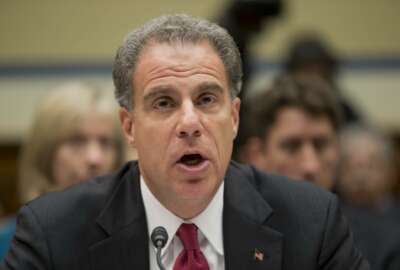

HHS' Office of Inspector General is giving its agents on-the-ground a chance to tell their stories, in their own words.
Government fraud, waste and abuse takes many forms, but for the Department of Health and Human Services’ Office of the Inspector General, tracking down improper payments from Medicare and Medicaid can take months, even years, of detective work.
In fiscal 2017, the Council of the Inspectors General on Integrity and Efficiency (CIGIE) reported that federal IGs identified more than $20 billion in potential cost savings — the third consecutive year it reached that benchmark.
Over the last three years, HHS OIG has recovered more than $10 billion in Medicare and Medicaid fraud and launched nearly 5,000 criminal and civil legal cases.
Now HHS’ watchdog office is giving its agents on-the-ground a chance to tell their stories, in their own words.
Last month, the OIG launched its podcast, “This is Real,” giving listeners a behind-the-scenes look at how its agents track down and prevent Medicare and Medicaid fraud.
“We wanted to highlight some of the particular cases. Some of the ones that we thought would be of interest to the public,” Agent Curtis, a 10-year veteran of the agency, said in an interview with Federal News Radio.
In order to protect the identities of agents that continue to go undercover for their jobs, the OIG’s podcast uses pseudonyms to refer to its agents.
In February 2014, an HHS OIG investigation lead to the arrest of more than 30 people on health care fraud charges in the Washington, D.C. metro area. The bust remains the largest case of health care fraud in the area.
In making the arrests, the IG office worked closely with the U.S. Attorneys’ Office, the FBI, the D.C. Office of Inspector General, the Centers for Medicare and Medicaid Services (CMS) and the D.C. Department of Health Care Finance.
But in order to arrest the office workers, personal care assistants and patient recruiters involved in the case, HHS OIG had to sift through the billions of health care claims that the Centers for Medicare and Medicaid Services receive from providers every day.
Using data analytics tools, the agency watchdog is able to track certain trends in the claims data, and investigates unusual data trends.
That’s how agents became aware of a large increase in home health care and personal care services billed to Medicare and Medicaid in the D.C. area.
“The spike from one year to the next just increased dramatically,” Curtis said, referring to a surge in claims in 2014. “When there’s no logical explanation, you really need to start to look at those types of things. We use data and data analytics a lot in our cases, and it’s driven by numbers. Some of the times, it’s how we get our cases.”
In reviewing these cases, HHS OIG investigators became suspicious when several claims listed hypertension — high blood pressure — as the primary reason cited for home care services.
Home care services are usually reserved for Medicare and Medicaid recipients with severe physical disabilities that prevent them from seeing a doctor.
“When you start to see hypertension as the number-one cause to justify home health care, and that cause doesn’t marry up well with the regulations, that’s the proper use of data analytics,” Curtis said.
As HHS OIG continued its investigation, it found that fraudsters had been recruiting people from homeless shelters and using their Medicaid benefits to bill for expensive home health care services.
In order to track down the bogus health care billing, Agent Rogers — another pseudonym — agreed to go undercover as a homeless man and meet with the fraudsters recruiting out of homeless shelters.
For a year, Rogers visited homeless shelters in D.C. wearing an outfit that consisted of baggy, unwashed jeans and an oversized t-shirt.
“I didn’t shave, I didn’t cut my hair,” Rogers said. “Maybe not bathe for a couple of days, if necessary.”
But in addition to looking the part, Rogers said he had to make sure that he was mentally prepared for his role. While undercover, Rogers had to commit to memory a false address, Social Security number and date of birth.
“I would literally rehearse that on a daily basis, because I never wanted to get tripped up. I never wanted them see me sweat,” he said.
Despite health care fraud having a reputation as “white-collar crime,” Curtis said agents constantly find themselves in dangerous situations while on the job.
“I can’t tell you how many search warrants I’ve been on where, during the execution of the search warrant, we come across weapons — and lots of weapons. It’s a common thing that we see in our investigations. All the agents realize that just because it’s white-collar crime doesn’t mean it’s not dangerous,” he said.
In the aftermath of the 2014 takedown, which led to 30 arrests, most of the defendants pleaded guilty, and were sentenced to pay more than $120 million in fines, restitution, and forfeiture.
HHS OIG has regional offices in nearly every state, and multiple field offices in each state.
“As an IG shop, we’re kind of unique in that we look outwards tremendously. At lot of our focus is outwards,” Curtis said. “We’re out and we’re in the field. We’re investigating providers — the doctors, the hospitals — so our agents are out every day, conducting interviews in the field, trying to ferret out the fraud, waste and abuse that’s occurring in our programs.”
Copyright © 2024 Federal News Network. All rights reserved. This website is not intended for users located within the European Economic Area.
Jory Heckman is a reporter at Federal News Network covering U.S. Postal Service, IRS, big data and technology issues.
Follow @jheckmanWFED



